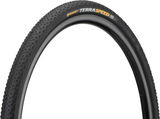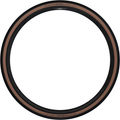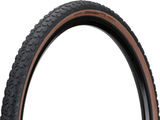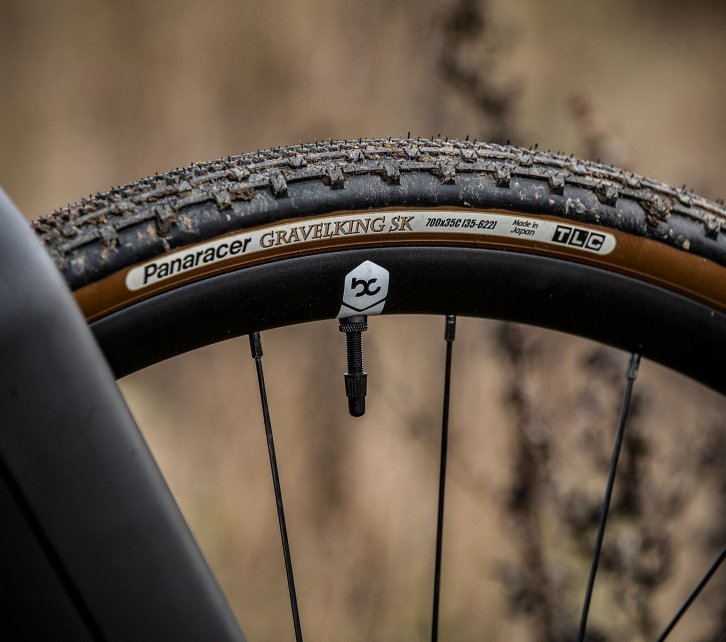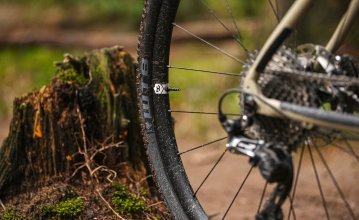Agile on gravel, low rolling resistance on asphalt, plenty of grip in fast corners and puncture-proof enough for off-road excursions: hardly any bicycle tyre must meet such a variety of requirements as the gravel bike tyre. This is another reason why gravel tyres come in multiple designs – some bearing a closer resemblance to mountain bike tyres, others more strongly favouring road bike tyres. One common feature: tyre dimensions of 27.5 (650b) or 28 inches (700c) diameter with typical widths between 30 and 70 millimetres have become the norm for gravel tyres. Read further and discover more.
Gravel Tyre Highlights
bc Insights on Gravel Tyres
Tyre dimensions on a gravel bike: width and diameter
Tyre dimensions in the cycling world are given in inches or centimetres, or sometimes both. This results in a confusion of different designations. The good news is that it's not as complicated as it seems. The designation according to ETRTO (European Tyre and Rim Technical Organisation) is very precise. It consists of two parts:
- The number before the hyphen indicates the width in millimetres
- The number behind the hyphen indicates the inner diameter of the tyre in millimetres
For example, the designation 40-622 indicates that the given gravel tyre has a width of 40 millimetres and an inner diameter of 622 millimetres. By the way: The inner diameter of the tyre is identical to the bead seat on the rim (Bead Seat Diameter - BSD).
If you want to use your gravel bike for occasional cyclocross races, you should observe the UCI limit of 33 millimetres width.
Gravel tyre diameter in inches
Besides measurements in centimetres, indications in inches and the so-called French designations are also widespread, but the latter only for the diameter. While mountain bikers are used to hearing measurements in inches, roadies are often more familiar with French terminology. In addition, the outside (OD) and inside diameters (ID) of tyres and the bead seat of the rim get mixed up in the designations. Our overview will help you here.
| Inch Designation | ETRTO Designation | French Designation |
| 26" (≙ OD Tyres) | 559 (≙ BSD Rim) | - |
| 27,5" (≙ OD Tyres) | 584 (≙ BSD Rim) | 650b |
| 28/29" (≙ OD Tyres) | 622 (≙ BSD Rim) | 700c |
Tyre width in inches
It's very simple! One inch corresponds to 25.4 millimetres. Which unit a manufacturer uses is a matter of taste. However, a small pattern can often be discerned: the closer a gravel tyre is to a mountain bike tyre in design, the more likely the manufacturer will (also) state the width in inches.
Tubeless tyres on a gravel bike
Tubeless means the tyre functions without a tube. By eliminating the tube between the gravel tyre and the rim, you can ride with lower tyre pressure. This benefits both rolling behaviour and grip in equal measure. At the same time, breakdowns caused by pinched tubes (also known as "snakebite") are a thing of the past. Tubeless tyres are ridden with sealant, which not only guarantees air retention between the rim and the tyre, but also automatically seals small holes and cuts. Tubeless gravel tyres (and rims) can be found using our "Tubeless Ready” filter.
The carcass: the backbone of your gravel tyre
The carcass is the basic structure of every tyre and consists of various fabric layers. The fineness of the fabric is given in TPI (threads per inch). The higher this number, the finer the basic construction of the tyre. Dense fabrics tend to have a positive effect on the tyre's puncture protection, puncture resistance, cut resistance and rolling resistance . The last case refers to the tyre hugging the ground. This is also referred to as "souplesse".
Using technology for a puncture-proof gravel tyre
Apart from the carcass, tyre manufacturers also have other ways of improving the above-mentioned properties, such as with an insert between the carcass and the tread or sidewall, or on the sidewall. Schwalbe calls its technology SnakeSkin, Specialized GridRace, at Continental it is called ProTection – different methods, same goal! See our comprehensive product descriptions for details.
Folding and wired tyres
Gravel tyres are available as folding and wired tyres. The difference lies in the bead core that connects the tyre and the rim, not in the carcass. Wired tyres are easy to mount and are optimised for use with tubes. Modern performance bikes now almost exclusively use folding tyres, which are lighter and usually tubeless-ready.
Gravel tyre tread
Perhaps the most visually striking feature of a gravel tyre is the tread. Its design has a direct effect on the running characteristics of the tyre. Open treads offer good self-cleaning, while closed blocks tend to optimise rolling characteristics. Higher tread blocks interlock better with loose ground, prominent shoulder lugs increase grip in curves, while flatter profiles and bevelled tread blocks roll more easily. Every manufacturer finds its own way to "square the circle" here.
Rubber compound on gravel tyres
The rubber compound is at least as important as the tread. This is about the rubber used for the surface and tread. Different degrees of hardness are used, measured in Shore durometers (a). The lower the number, the softer the rubber. Some manufacturers, such as WTB, use multiple compounds on select tyre models, such as softer rubber (e.g. 42a) on the shoulder lugs and harder rubber (e.g. 60a) on the tread. Vittoria adds graphene to its compounds. Among other factors, the hardness of the rubber compound also has an influence on how well your gravel tyre performs during winter.
What tyre pressure should be used on a gravel bike?
- Observe the tyre manufacturer's minimum and maximum pressure limits (printed on the tyre sidewall)
- For carbon rims, check the rim manufacturer's operating instructions and observe the maximum pressure
Otherwise, there is no general answer to the question. The narrower the tyre and the more often you are on the road, the higher pressure you will ride. Wide tubeless gravel tyres can tolerate lower pressures. Frequent off-road excursions even make them necessary.








